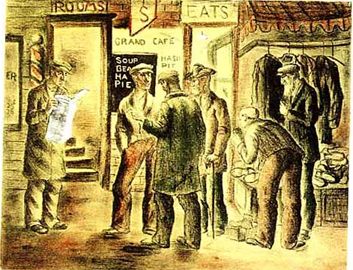Gateway District
Minneapolis (1917-1962)
| This area is the oldest neighborhood in Minneapolis, though little structural evidence remains as testament. Assuming that homosexuality and gender fluidity have been ever-present in the city, the Gateway District remains the oldest site of queer life in the city.
|
The Gateway District in 1929, shortly after workers finished The Nicollet Hotel. Photo by Norton & Peel, Courtesy of the Minnesota Historical Society. |
The success of milling and related industries funded early suburbanization on the outskirts of what is now downtown. Neighborhoods such as Steven's Square, Loring Park, and Kenwood filled in with mansions and upscale commercial establishments.
By the turn of the 20th century, this expansion left pioneer-era spaces vacant and disreputable filled the vacuum.(2) Newspapers noted homosocial activity, prostitution, gambling, public alcoholism, and other examples of criminal activity by the turn of the century.(3) Responding to this, civic fathers built the Great Northern Depot and Gateway Park in the 1910s, and encouraged the construction of the New Nicollet Hotel and the Hotel Andrews, giving the troubled area a new motto: “The Gateway: More Than Her Arms, the City Opens Her Heart to You.”(4)
| "Evening in the Gateway" by Dorothea Lau. Courtesy of the Minnesota Historical Society |
This motto proved to be misleading and eventually ineffective; the Minneapolis Police Department spent much of their time quelling the sexual and social behaviors of the indigent laborers, mischievous businessmen, diverse prostitutes, and murderous drag queens who prowled the new Gateway District. (5)
As time progressed, foundational elements of downtown Minneapolis’ vitality—milling, warehousing, and the railroads—dwindled and vanished, leaving the once-tolerated working poor open to harassment. |
By the late 40s, The Gateway became an embarrassment and, with funding from the Federal Government, the City of Minneapolis demolished much of it in the late 1950s and early 1960s. (6) Not all of the socially unacceptable uses vanished—the Gateway remains the central site of Minneapolis’ gay nightlife and bar scene. The Gay 90s Complex, the Brass Rail Bar, and the Minneapolis Eagle operate within the district's remaining fragments.
This entry is part of:
Minneapolis/St. Paul, MN: 100 Queer Places in Minnesota History, (1860-2010)
(1)Pennefetaher, Susan M. Mill City: A Visual History of the Minneapolis Mill District. St. Paul: Minnesota historical Society Press, 2003.
(2)Millet, Larry. Twin Cities Then and Now. St. Paul: Minnesota Historical Society Press, 1996. Pages 16-17.
(3)“Moral Wave in Le Page Saloon,” The Minneapolis Journal, March 29, 1908., “71 Jailed in 4 night raids by Sheriffs,” The Sunday Journal, April 18, 1915., etc.
(4)“Gateway Glory Fades to Dust” The Minneapolis Star, October 23, 1953, local news section, front page.
(5) Information on this activity is available in the records of the Minneapolis Police Department, located in the Records division of the City Clerk's Office.
(6)Millet, Ibid.

